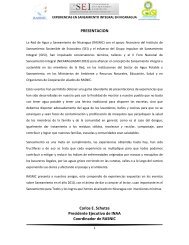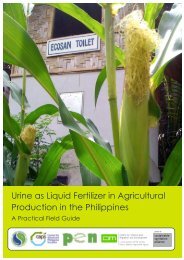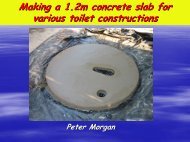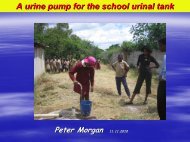Open Planning of Sanitation Systems
Open Planning of Sanitation Systems
Open Planning of Sanitation Systems
You also want an ePaper? Increase the reach of your titles
YUMPU automatically turns print PDFs into web optimized ePapers that Google loves.
<strong>Open</strong> <strong>Planning</strong> <strong>of</strong> <strong>Sanitation</strong> <strong>Systems</strong>REFERENCESvan der Vleuten-Balkema, A. 2003. Sustainable Wastewater <strong>Systems</strong> – Developing a Methodology and SelectingPromising <strong>Systems</strong>. Dissertation, Technische Universiteit, Eindhoven, the Netherlands.Hellström, D., Jeppsson, U., & Kärrman, E. 2000. <strong>Systems</strong> Analysis <strong>of</strong> Urban Water Management. EnvironmentalImpact Assessment Review, 20 (3).Holden, R. 2003. Factors which have influenced the acceptance <strong>of</strong> ecosan in South Africa and development <strong>of</strong> amarketing strategy. Ecosan – closing the loop. Proceedings <strong>of</strong> the 2 nd international symposium on ecologicalsanitation, April 7 – 11, 2003, held in Lübeck, Germany.Larsen, T. & Lienert, J. 2003. Societal Implications <strong>of</strong> Re-Engineering the Toilet. Water Intelligence Online, March2003.Larsen & Gujer 1997. The concept <strong>of</strong> sustainable urban water management. Wat. Sci. Tech 35(9), p 3-10.Lennartsson, M. 2004. Review <strong>of</strong> Alternative <strong>Sanitation</strong> <strong>Systems</strong>. EcoSanRes working paper, draft version.Tischner, U. & Schmidt-Bleek, F. 1993. Designing goods with MIPS. Fresenius Envir. Bull., vol 2, pp 479-484.Urban Water, 2004. MIKA – Methodologies for Integration <strong>of</strong> Knowledge Areas. Surahammar Case Study (draftin Swedish).WSSCC, 2000. Report <strong>of</strong> Environmental <strong>Sanitation</strong> Working Group for 5 th Global Forum. Water Supply and<strong>Sanitation</strong> Collaborative Council (WSSCC), Geneva, Switzerland.Appendix 2: Review <strong>of</strong> Some Existing <strong>Sanitation</strong> <strong>Planning</strong> andImplementation Tools from an Ecological <strong>Sanitation</strong> PerspectiveEcological sanitation entails the hygienically safe reuse <strong>of</strong> human excreta in agriculture. The pillars<strong>of</strong> ecological sanitation are containment, sanitization and nutrient reuse 2 . Thus, ecological sanitationprojects entail involvement with at least one more field than conventional sanitation projects, it beingagriculture. There is therefore a need to review existing sanitation planning and implementation tools,in order to assess their capacity to fully include all aspects <strong>of</strong> ecological sanitation. Our attempt in thissection <strong>of</strong> the report is to review some existing sanitation planning and implementation tools from anecological sanitation perspective. For a more extensive survey we recommend the ecosan source bookfor the preparation and implementation <strong>of</strong> ecosan projects, currently being compiled by the ecosan teamat GTZ (www.gtz.de). Worth mentioning here is the SANEX s<strong>of</strong>tware, developed at the University <strong>of</strong>Queensland, Australia and co-financed by the Swiss Development Cooperation (Loetcher & Keller,2002). However, this tool is not further analysed in this report.PHAST/SARAR (WOOD ET AL., 1998)Background/aim <strong>of</strong> toolThe PHAST/SARAR guide was developed to help community workers promote community hygienebehaviour change and to improve water and sanitation facilities. This is achieved by demonstration<strong>of</strong> the relationship between sanitation and health status, by increasing self-esteem <strong>of</strong> the communitymembers, and by empowerment <strong>of</strong> the community to plan environmental improvements and to own andoperate water and sanitation facilities.The guide presents seven steps, <strong>of</strong> which the first five take the community through the development<strong>of</strong> a plan to prevent diarrhoeal diseases by improving its water supply, hygiene behaviour and sanitation.Steps six and seven are about monitoring and evaluation.2http://www.ecosanres.org19



![Project Document [PDF: 2.31 MB] - EcoSanRes](https://img.yumpu.com/51279385/1/184x260/project-document-pdf-231-mb-ecosanres.jpg?quality=85)












![Latrines à compost [high-resolution colour PDF: 12.3MB] - EcoSanRes](https://img.yumpu.com/31726141/1/185x260/latrines-a-compost-high-resolution-colour-pdf-123mb-ecosanres.jpg?quality=85)